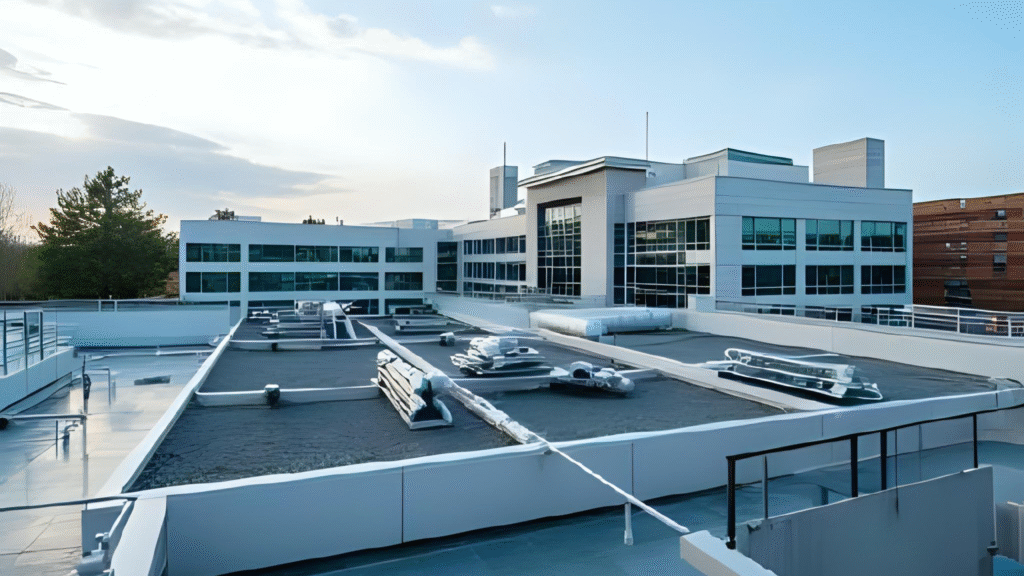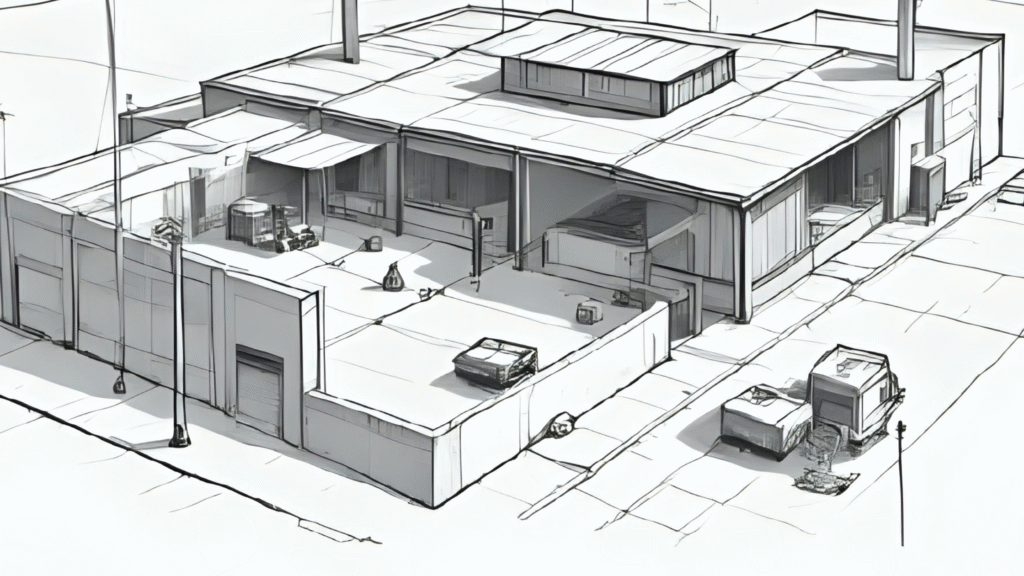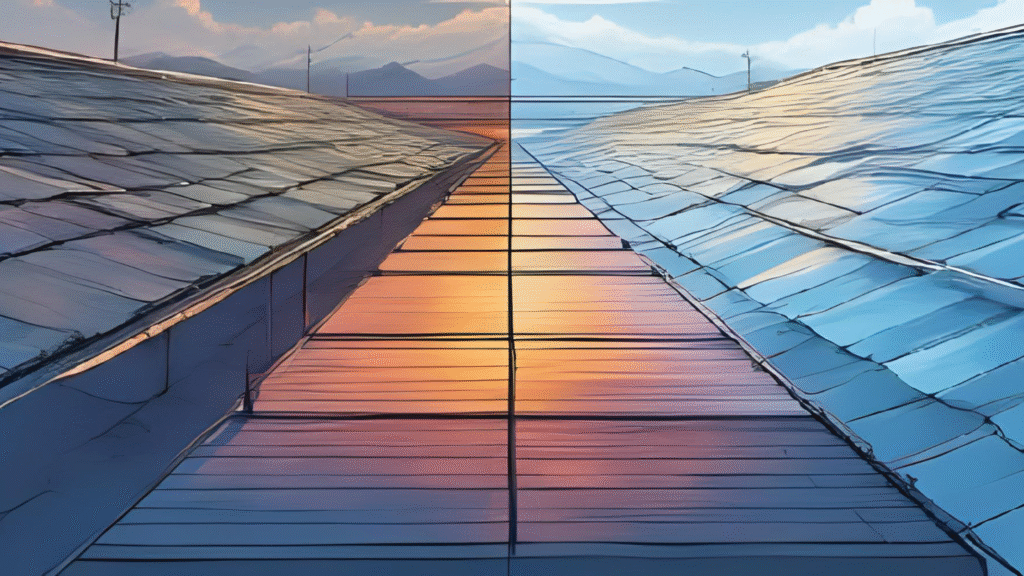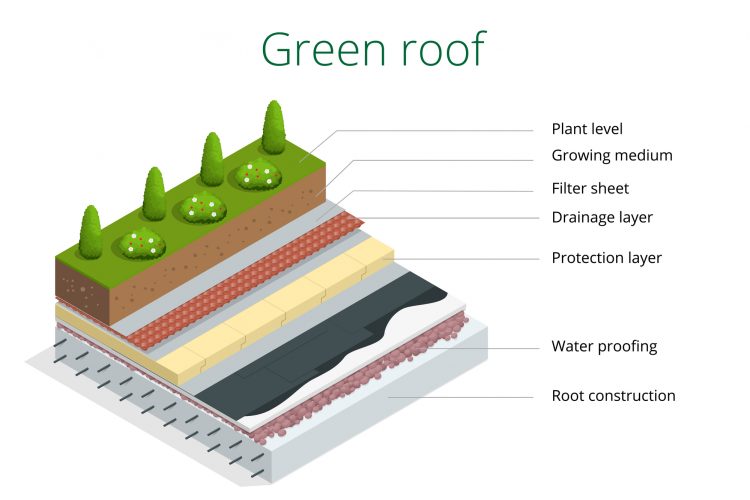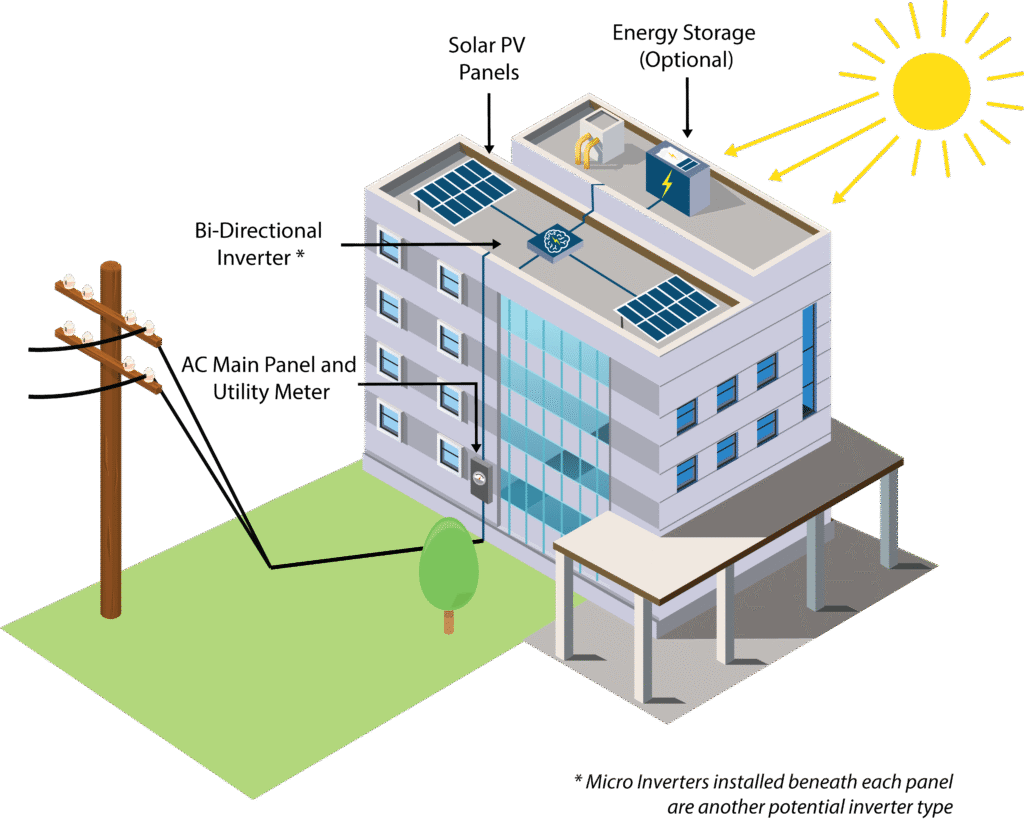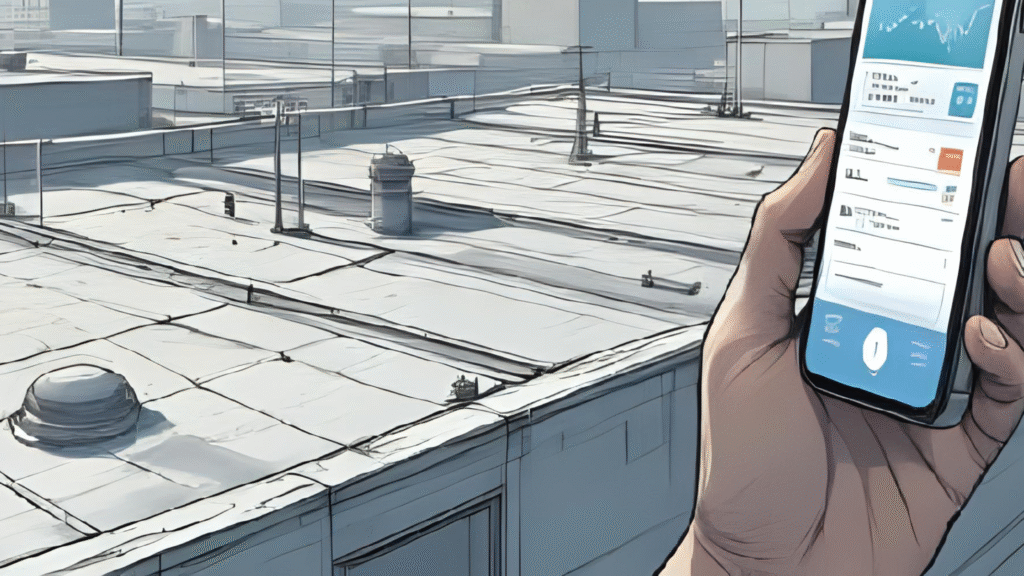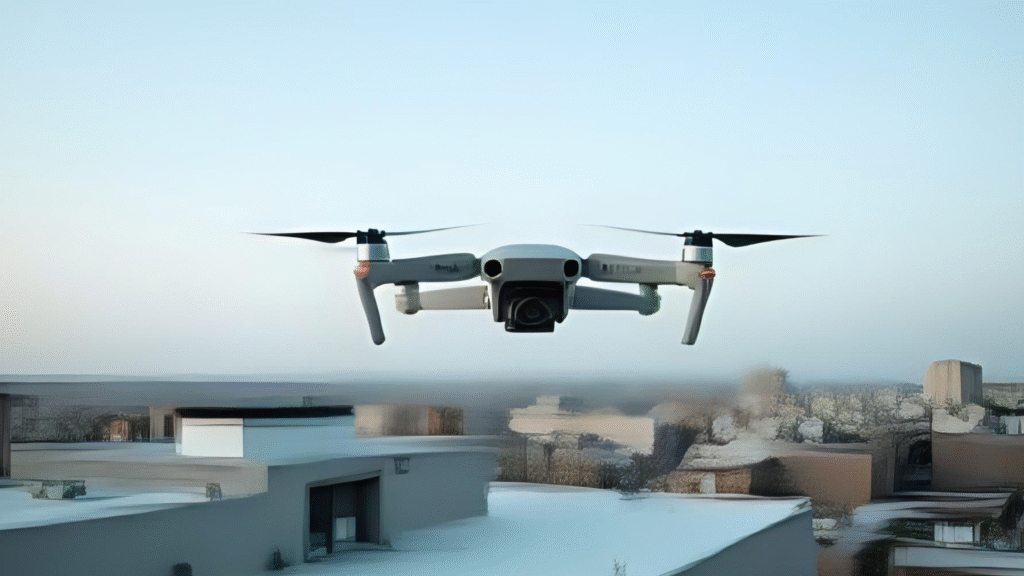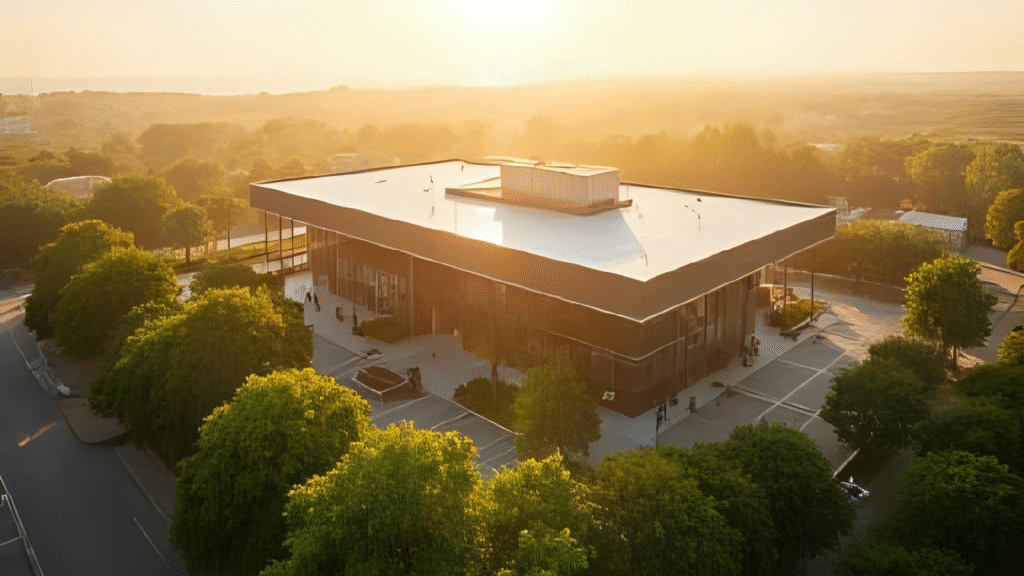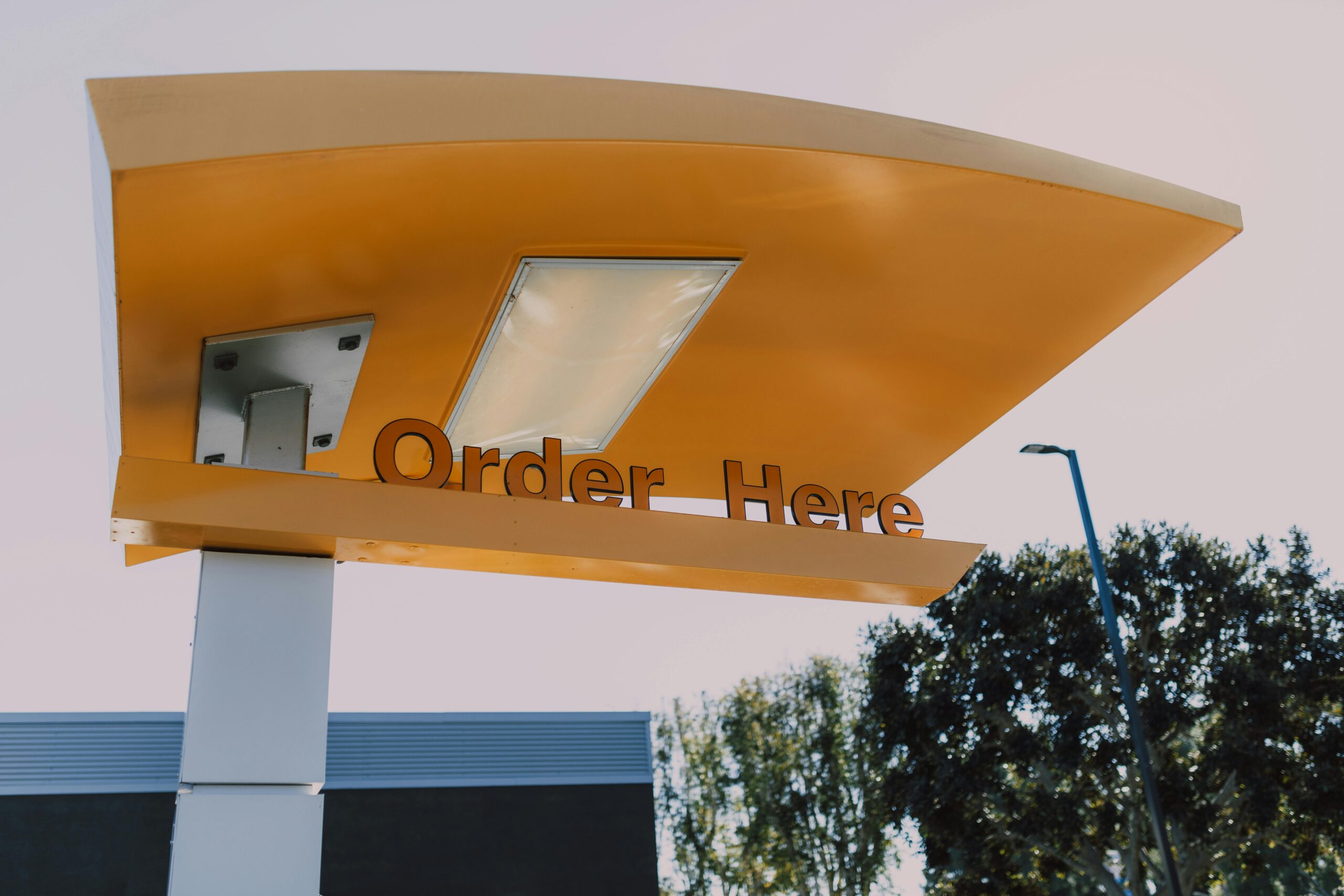In the dynamic world of commercial property ownership, staying ahead of the curve isn’t just an advantage – it’s a necessity. Every square foot of your commercial building plays a role in its efficiency, longevity, and bottom line, and perhaps no component is as critical, yet often overlooked, as your roof. It’s not just a cap on your building; it’s a vital, evolving system that impacts everything from energy consumption to structural integrity and even your brand’s sustainability footprint.
The commercial roofing industry is undergoing a remarkable transformation. Gone are the days of roofs being mere passive protectors; today’s innovations are turning them into active assets that can slash energy bills, enhance operational efficiency, and provide long-term resilience against unpredictable weather. As a commercial business owner, understanding these cutting-edge trends isn’t just about making smarter investment decisions; it’s about future-proofing your most valuable physical assets and gaining a significant competitive edge.
This comprehensive guide will dive deep into the latest trends and innovations shaping commercial roofing. We’ll explore the sustainable solutions that save you money and the planet, the smart technologies that put real-time data at your fingertips, and the advancements in materials that promise unprecedented durability. By the end, you’ll have a clear roadmap to selecting, maintaining, and optimizing a commercial roof that doesn’t just protect your business today but thrives with it into the future.
Sustainable & Eco-Friendly Roofing Solutions: Investing in a Greener, More Efficient Future
In an era where sustainability isn’t just a buzzword but a core business principle, your commercial roof stands ready to be a powerful environmental and economic asset. Modern advancements are transforming roofs into active contributors to energy efficiency, waste reduction, and a healthier environment. For commercial property owners, embracing these eco-friendly solutions means more than just doing good; it means significant long-term savings, enhanced property value, and a stronger brand reputation.
Let’s explore the leading sustainable roofing innovations:
1. Cool Roofs: Reflecting Your Way to Massive Energy Savings
Imagine a roof that actively pushes away heat from your building. That’s the power of a cool roof. These systems are designed with highly reflective surfaces that minimize solar heat gain, significantly reducing the amount of heat absorbed into your building. Unlike traditional dark-colored roofs that can reach scorching temperatures, cool roofs stay much cooler, even on the hottest days.
What They Are: Cool roofs can be achieved through various methods, including:
- Highly Reflective Coatings: Often made of acrylics, silicones, or urethanes, these liquid-applied coatings are retrofitted onto existing roof membranes. They cure to form a seamless, reflective layer. Commercial Roof Coatings: A Detailed Guide
- Specialized Membranes: Materials like white TPO (Thermoplastic Polyolefin) or PVC (Polyvinyl Chloride) are inherently light-colored and designed with high solar reflectance and thermal emittance properties. Energy Star for Roof Products or Cool Roof Rating Council (CRRC) website
- Light-Colored Roofing Materials: Certain lighter shades of metal or single-ply membranes are also classified as cool roofing materials.
How They Work: It’s all about solar reflectance and thermal emittance. Solar reflectance (or albedo) is the percentage of solar energy reflected by the roof surface. Thermal emittance is the ability of the roof surface to radiate absorbed heat. A cool roof boasts both high solar reflectance and high thermal emittance, meaning it sends sun’s rays back into the atmosphere and quickly releases any heat it does absorb.
Benefits for Commercial Owners:
- Substantial Energy Cost Reduction: By keeping your building cooler, cool roofs dramatically decrease the workload on your HVAC systems, leading to significant savings on air conditioning bills, especially in warmer climates like Wylie, Texas. The ROI of Energy-Efficient Commercial Roofing
- Extended Roof Lifespan: Reduced thermal shock (the expansion and contraction caused by extreme temperature swings) means less stress on your roofing materials, potentially extending your roof’s service life.
- Improved Indoor Comfort: A cooler roof means a more comfortable indoor environment for your employees and customers, potentially increasing productivity.
- Reduced Urban Heat Island Effect: On a broader scale, widespread adoption of cool roofs in urban areas can help mitigate the “urban heat island effect,” where cities are significantly warmer than surrounding rural areas.
- Potential Incentives: Many regions and utility providers offer rebates, tax credits, or other incentives for installing energy-efficient cool roofs. Database of State Incentives for Renewables & Efficiency (DSIRE)
Potential Challenges & Considerations: While the benefits are compelling, consider the initial cost, which can be higher than traditional dark roofs, though quickly offset by energy savings. Proper installation is crucial for performance and longevity.
Innovations: Research continues to advance reflective coating technology, offering even greater performance and durability, some with self-cleaning properties that maintain reflectivity over time.
2. Green Roofs (Living Roofs): Your Building’s Natural Insulator & Stormwater Manager
Imagine a vibrant garden thriving on top of your commercial building. That’s a green roof – an innovative system that transforms unused roof space into a living, breathing ecosystem. More than just aesthetically pleasing, green roofs are powerful environmental assets.
What They Are: A green roof typically consists of a waterproof membrane, a drainage layer, a filter membrane, a growing medium (soil), and vegetation.
- Extensive Green Roofs: These are lightweight systems with shallow growing media, typically supporting low-maintenance plants like sedums and grasses. They are ideal for existing structures with limited load-bearing capacity.
- Intensive Green Roofs: These are heavier systems with deeper growing media, capable of supporting a wider variety of plants, including shrubs and trees, creating accessible park-like spaces. These require significant structural support.
How They Work: The layers of vegetation and growing medium act as natural insulation, reducing heat transfer into and out of the building. They also absorb vast amounts of rainwater, releasing it slowly or allowing it to evaporate, which significantly reduces stormwater runoff.
Benefits for Commercial Owners:
- Exceptional Energy Savings: The insulating properties of green roofs can drastically reduce heating and cooling costs, providing a natural barrier against temperature fluctuations.
- Superior Stormwater Management: By absorbing and detaining rainwater, green roofs alleviate pressure on municipal drainage systems, reducing the risk of flooding and potentially leading to stormwater management credits.
- Extended Roof Membrane Lifespan: The vegetation layer protects the underlying roof membrane from harsh UV radiation and extreme temperature swings, significantly extending its life.
- Improved Air Quality: Plants filter pollutants from the air, contributing to cleaner surrounding environments.
- Enhanced Biodiversity: Green roofs can provide valuable habitats for insects and birds, especially in urban areas.
- Noise Reduction: The layers of a green roof absorb sound, reducing both external noise entering the building and internal noise escaping.
- Increased Property Value & Aesthetic Appeal: A green roof can be a unique selling point, enhancing the visual appeal and market value of your property, attracting tenants, and fostering a positive brand image.
- Potential for LEED Points: Green roofs contribute significantly to LEED (Leadership in Energy and Environmental Design) certification, a widely recognized symbol of sustainability achievement.
Potential Challenges & Considerations: Green roofs generally have a higher upfront cost than traditional roofs and require structural assessment due to their weight. Ongoing maintenance, though often minimal for extensive systems, is also a factor.
Innovations: Newer systems are lighter, modular, and designed for easier installation, making green roofs more accessible for a wider range of commercial buildings. Advanced drainage layers ensure optimal performance.
3. Solar-Integrated Roofing: Generating Power from Your Property’s Crown
Harnessing the sun’s energy directly from your roof is no longer a futuristic concept; it’s a rapidly growing reality for commercial properties. Solar-integrated roofing solutions seamlessly blend photovoltaic (PV) technology into your building’s design, turning your roof from a mere protective layer into an active power generator.
What They Are:
- Traditional Solar Panels: While not strictly “integrated” into the roof material itself, these are the most common form, mounted securely on top of existing commercial roofs. Advances in mounting systems make them increasingly efficient and less intrusive.
- Building-Integrated Photovoltaics (BIPV): This is where true integration happens. BIPV refers to solar technology that replaces conventional roofing materials, such as solar shingles, tiles, or membranes with embedded PV cells. These offer a sleek, often invisible, aesthetic while still producing electricity. Examples of Commercial BIPV Projects or Solar Energy Industries Association (SEIA) resources
How They Work: Photovoltaic cells convert sunlight directly into electricity. This clean energy can then be used to power your building, reducing reliance on the grid and significantly cutting operational electricity costs. Excess energy can often be fed back into the grid, potentially earning you credits through net metering programs.
Benefits for Commercial Owners:
- Significant Energy Cost Reduction: The most obvious benefit is the dramatic decrease, or even elimination, of your monthly electricity bills. This translates to substantial long-term savings.
- Energy Independence & Resilience: Generating your own power reduces vulnerability to grid outages and fluctuating electricity prices.
- Reduced Carbon Footprint: Investing in solar energy demonstrates a strong commitment to environmental stewardship, appealing to eco-conscious customers and partners.
- Enhanced Property Value: Buildings with solar installations are often more attractive to potential buyers or tenants due to their lower operating costs and1 modern amenities.
- Attractive Incentives: Beyond net metering, numerous federal, state, and local incentives, such as the Investment Tax Credit (ITC) in the U.S., can significantly offset the initial installation costs. U.S. Department of Energy Solar Tax Credit information
- Extended Roof Lifespan: Solar panels can act as a protective layer, shielding the underlying roof membrane from direct UV exposure and extreme weather, potentially extending its life.
Potential Challenges & Considerations: The upfront investment for solar installation can be substantial, though incentives often mitigate this. Roof suitability (size, angle, shading, and structural integrity) is crucial, and local regulations or HOA rules may apply. Is Your Commercial Roof Ready for Solar?
Innovations: Advancements are leading to more efficient solar cells that generate more power from smaller areas, more aesthetically pleasing integrated designs, and improved battery storage solutions that allow businesses to store excess power for use during peak demand or outages.
4. Recycled & Upcycled Materials: Building Smarter, Wasting Less
The push for sustainability is also transforming the very composition of roofing materials. The commercial roofing industry is increasingly adopting innovative solutions that utilize recycled and upcycled content, minimizing environmental impact while delivering high-performance results.
What They Are: These are roofing products manufactured wholly or partially from materials that would otherwise end up in landfills. Examples include:
- Recycled Rubber & Plastic: Often used in durable, flexible membranes or tiles that mimic slate or wood shakes.
- Recycled Metal: Aluminum and steel can be recycled indefinitely without degradation, making them excellent choices for long-lasting metal roofing systems.
- Post-Industrial Waste Composites: Materials made from byproducts of other manufacturing processes, diverted from waste streams.
How They Work: By diverting waste materials and giving them a new life in roofing products, these solutions reduce landfill burden, conserve virgin natural resources, and often have a lower embodied energy (the energy consumed by all processes associated with the production of a product).
Benefits for Commercial Owners:
- Environmental Leadership: Demonstrates a strong commitment to corporate social responsibility and sustainable practices.
- Reduced Waste: Actively participates in the circular economy, minimizing demand for new raw materials.
- Durability & Performance: Many recycled materials offer excellent resistance to harsh weather, impact, and UV degradation, often with impressive lifespans.
- Potential Certifications: Use of recycled content can contribute to green building certifications like LEED.
- Competitive Cost (in some cases): While not always the cheapest upfront, the environmental benefits and long-term durability can offer significant value.
Potential Challenges & Considerations: Availability can sometimes be a factor, as can varying product specifications. It’s crucial to select materials from reputable manufacturers with proven performance records.
Innovations: Ongoing research is improving the performance, aesthetic range, and cost-effectiveness of recycled roofing materials, making them an increasingly viable and attractive option for commercial projects.
Advanced Roofing Technologies: Unlocking Data, Efficiency, and Predictive Power
The digital revolution isn’t just happening inside your office; it’s extending all the way to your roof! Integrating cutting-edge technologies like sensors, artificial intelligence, and robotics is transforming how commercial roofs are monitored, maintained, and managed. For commercial business owners, these innovations offer unprecedented levels of insight, allowing for proactive decision-making, significant cost avoidance, and enhanced operational continuity.
Let’s explore how technology is making your roof smarter and more efficient:
1. Smart Roofing Systems (IoT Integration): Your Roof’s Real-Time Health Monitor
Imagine knowing about a potential leak the moment it starts, or being alerted to abnormal temperature fluctuations before they escalate into an energy drain. That’s the promise of smart roofing systems, which integrate Internet of Things (IoT) sensors directly into the roof’s structure.
What They Are & How They Work: These systems embed a network of sensors within the roofing assembly. These sensors can monitor a variety of critical parameters:
- Moisture Detection: Sensors identify the presence of water within the roof assembly, pinpointing leaks or areas of saturation long before they become visible inside the building. The Hidden Dangers of Commercial Roof Leaks
- Temperature & Thermal Performance: Sensors track temperature fluctuations, identifying insulation breakdown, heat bridges, or areas where your HVAC system is working harder than it should.
- Structural Strain: In some advanced systems, sensors can even monitor subtle shifts or stress points, offering early warnings of potential structural issues.
- Drainage Efficiency: Sensors can detect if drains are clogged or if ponding water is accumulating, preventing long-term damage.
The data collected by these sensors is transmitted wirelessly to a central monitoring system, often accessible via a web portal or mobile app. This provides facility managers and business owners with real-time insights into their roof’s condition, anytime, anywhere.
Benefits for Commercial Owners:
- Proactive Problem Detection: The most significant advantage is the ability to detect issues like leaks or insulation failures early, often before they cause damage to interiors, inventory, or equipment. This shifts maintenance from reactive (emergency repairs) to proactive (preventative interventions).
- Cost Avoidance: Early detection means minor repairs instead of costly, extensive damage. Preventing catastrophic failures saves immense amounts on repairs, downtime, and potential insurance claims.
- Optimized Energy Usage: By pinpointing areas of insulation inefficiency, smart roofs help optimize heating and cooling, leading to further energy savings.
- Extended Roof Lifespan: Addressing minor issues promptly prevents them from escalating, contributing to a longer overall service life for your roof.
- Data-Driven Maintenance: No more guessing games. You’ll have precise data to guide your maintenance schedule and budget, ensuring resources are allocated effectively.
- Enhanced Safety & Compliance: Real-time monitoring can help ensure your roof remains structurally sound and compliant with safety regulations.
Potential Challenges & Considerations: The initial investment in smart roofing technology can be higher than traditional systems. Data management and cybersecurity for the IoT network are also important considerations. It’s crucial to partner with providers who offer robust, secure platforms.
Innovations: Integration with broader building management systems (BMS) is becoming more common, allowing for holistic control of your facility. AI-powered analytics are emerging to interpret sensor data, identify patterns, and offer predictive maintenance recommendations, moving beyond just alerts to true foresight.
2. Drone Inspections & AI Analysis: Safer, Faster, Smarter Roof Assessments
Manual roof inspections can be time-consuming, expensive, and present safety risks. Enter drones and artificial intelligence – a powerful duo revolutionizing how commercial roofs are assessed.
What They Are & How They Work:
- Drone Technology: High-resolution cameras and thermal imaging capabilities mounted on drones can capture detailed aerial imagery and temperature readings of an entire roof surface in a fraction of the time it takes for a manual inspection.
- AI-Powered Analytics: Specialized software processes the vast amounts of data collected by drones. Using machine learning algorithms, the AI can automatically identify anomalies such as cracks, blisters, ponding water, compromised seams, hail damage, and even early signs of insulation failure. It can also generate detailed reports, often with precise measurements and GPS coordinates of problem areas.
Benefits for Commercial Owners:
- Enhanced Safety: Eliminates the need for personnel to access potentially dangerous roof areas, significantly reducing the risk of falls or accidents.
- Speed & Efficiency: A large commercial roof that might take days to inspect manually can often be fully scanned by a drone in just hours, minimizing disruption to your operations.
- Unparalleled Accuracy & Detail: Drones can capture angles and details that are difficult or impossible to see from the ground or even during a walk-over inspection. Thermal imaging reveals hidden moisture within the roof assembly.
- Objective & Consistent Data: AI analysis provides objective, consistent assessments, eliminating human error or subjective interpretation. This is invaluable for insurance claims or warranty purposes.
- Cost-Effectiveness: While there’s an initial cost for drone services, the speed, accuracy, and reduced labor costs can make them more economical for large or complex roofs in the long run.
- Pre- and Post-Project Documentation: Excellent for documenting roof conditions before and after repairs or new installations, providing a clear visual record.
Potential Challenges & Considerations: Drone operations are subject to FAA regulations in the U.S. and local airspace restrictions. The quality of the drone data depends heavily on the operator’s skill and the sophistication of the AI software.
Innovations: AI models are continually being trained on larger datasets, making them even more accurate at identifying subtle roof defects. The integration of multispectral cameras on drones can provide even deeper insights into material degradation.
Enhanced Durability & Performance: Building a More Resilient Roof
Beyond sustainability and smart technology, the commercial roofing industry is also constantly innovating to create materials and systems that simply last longer, withstand harsher conditions, and require less frequent intervention. These advancements translate directly to reduced maintenance costs, fewer disruptions, and greater peace of mind for business owners.
Let’s look at how materials and installation techniques are pushing the boundaries of roof longevity:
- Self-Healing & Self-Cleaning Roofs: Imagine a roof that can mend its own minor scratches or sheds dirt and grime with every rainfall. While still emerging, technologies are developing materials with remarkable properties. Some are designed with special polymers that can soften with heat to fill small punctures or scratches, effectively “healing” minor damage. Others incorporate hydrophobic or photocatalytic coatings that repel water, dirt, and pollutants, keeping the roof surface cleaner and maintaining its reflective properties over time.
- Benefits for Commercial Owners: This innovation holds the promise of significantly extending roof lifespan, reducing the need for minor repairs, and lowering ongoing maintenance costs. For areas like Wylie, Texas, where dust and debris can accumulate, self-cleaning properties would be a real advantage.
- Innovations: Research continues to refine these properties, aiming for broader application and greater efficacy in real-world conditions.
- Advanced Coatings & Membranes: While we touched on reflective coatings for cool roofs, the broader category of advanced coatings and single-ply membranes is evolving rapidly. Next-generation elastomeric, silicone, and acrylic coatings offer superior resistance to UV degradation, improved waterproofing capabilities, and enhanced flexibility to handle building movement and temperature fluctuations. Similarly, single-ply membranes like TPO (Thermoplastic Polyolefin) and PVC (Polyvinyl Chloride) are continually being engineered for greater thickness, stronger seam adhesion, and better overall resilience against punctures and tears. A Comparison of TPO vs. PVC Commercial Roofing
- Benefits for Commercial Owners: These advancements provide a cost-effective alternative to full roof replacement, often extending an existing roof’s life by many years. They offer superior protection against the elements, improved energy efficiency (especially with reflective options), and can be applied with minimal disruption.
- Innovations: Manufacturers are developing coatings with higher solar reflectance values, better adhesion properties to a wider range of substrates, and even more robust formulations for extreme weather conditions.
- Improved Impact & Wind Resistance: With increasingly unpredictable weather patterns, a roof’s ability to withstand severe storms, hail, and high winds is paramount. Innovations in roofing materials and installation techniques are specifically addressing this challenge. This includes the development of reinforced membranes, stronger fastening systems, and materials designed to achieve higher impact ratings (e.g., FM Global’s FM4470 standard or UL 2218 Class 4 impact resistance). These materials are tested rigorously to ensure they can resist large hail impact without fracturing.
- Benefits for Commercial Owners: Investing in high-impact and wind-resistant roofing dramatically reduces the risk of storm-related damage, minimizing costly repairs, potential downtime, and insurance claims. It offers peace of mind and ensures greater business continuity, especially vital in areas prone to severe weather.
- Innovations: Research focuses on composite materials and multi-layered systems that disperse impact energy more effectively, as well as enhanced adhesion technologies for improved wind uplift resistance.
The Business Owner’s Imperative: Why These Trends Matter NOW for Your Bottom Line
It’s clear that the commercial roofing industry is evolving at an unprecedented pace. For you, the commercial business owner, understanding and embracing these trends isn’t just about curiosity; it’s a critical strategic imperative that directly impacts your company’s financial health, operational resilience, and market standing.
Here’s why these innovations demand your immediate attention:
- Significant ROI and Cost Savings: This is often the first question on any business owner’s mind. From the dramatically reduced energy bills offered by cool roofs and solar integration to the long-term maintenance savings provided by self-healing materials and proactive smart systems, these innovations offer tangible returns on investment. Preventing a single major leak or extending your roof’s life by a decade can save hundreds of thousands of dollars in repairs, lost inventory, and business disruption. Calculating the ROI of Your Commercial Roof Investment
- Enhanced Operational Efficiency and Continuity: A smart roof that alerts you to potential issues before they become critical means less downtime for your operations. Knowing your roof is robust and resilient against extreme weather, especially here in areas like Wylie, Texas, where severe storms are a real concern, allows you to focus on your core business, not on emergency repairs.
- Boosted Property Value and Attractiveness: A modern, energy-efficient, and technologically advanced roof significantly enhances the market value of your commercial property. It makes your building more appealing to potential tenants or buyers who are increasingly looking for sustainable and low-maintenance assets.
- Meeting Sustainability Goals and Corporate Social Responsibility (CSR): In today’s market, environmental responsibility is no longer optional. Adopting green roofs, solar solutions, and recycled materials demonstrates a powerful commitment to sustainability. This resonates deeply with eco-conscious customers, partners, and even employees, enhancing your brand’s reputation and potentially opening doors to new business opportunities.
- Mitigating Risk and Ensuring Compliance: With advanced materials and smart monitoring, you can proactively identify and address risks, avoiding costly failures, insurance claims, and potential liabilities. Staying abreast of innovations also helps ensure your property remains compliant with evolving building codes and energy efficiency standards.
- Gaining a Competitive Edge: While some might view these innovations as expenses, forward-thinking business owners recognize them as strategic investments. Having a roof that actively contributes to savings, efficiency, and sustainability can differentiate your property in a competitive market, attracting premier tenants and maximizing profitability.
Future-Proofing Your Most Valuable Commercial Asset
Your commercial roof is far more than just a protective layer; it’s a dynamic, technologically advanced component of your business infrastructure. The trends in sustainable materials, smart monitoring systems, and enhanced durability are not fleeting fads but fundamental shifts poised to redefine commercial property ownership.
By actively exploring and adopting these innovations, you’re not just making a maintenance decision; you’re making a strategic investment in the longevity, efficiency, and overall success of your commercial enterprise. From the scorching summers of Texas to the unpredictable storms, a future-proof roof offers unparalleled protection and performance, empowering you to focus on what you do best: running your business.
Don’t let your roof be an afterthought. Now is the time to engage with knowledgeable commercial roofing professionals who can guide you through these exciting options and help you design, install, or upgrade a roof that doesn’t just protect your building today, but actively contributes to its prosperity for decades to come.
Ready to explore how the latest commercial roofing innovations can benefit your business? Contact us today for a comprehensive consultation and a personalized assessment of your property’s needs. Request a Consultation

